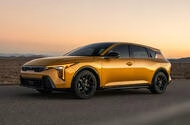Kia is making waves in the automotive world, and it’s not just about SUVs anymore. The company is doubling down on hatchbacks and saloons, aiming to capture a significant share of the market with new models that promise to rival some of the biggest names in the game, like the Volkswagen Golf and ID.3. This shift is particularly exciting for those who appreciate the versatility and practicality of hatchbacks, which have long been a staple in European driving culture.
What’s Driving Kia’s Hatchback Revival?
Kia’s executive vice-president, Ted Lee, recently shared insights into the brand’s strategy, emphasizing that there’s still a “big volume” market for hatchbacks in Europe. This is a refreshing take, especially as many manufacturers have leaned heavily into the SUV trend. Lee’s commitment to introducing new family hatchback models signals a recognition of consumer preferences that still favor this body style for its compactness and efficiency.
The first of these new offerings is the EV4, set to be the first electric Kia manufactured in Europe. Launching in the UK this October, the EV4 will be produced at Kia’s plant in Slovakia, with a saloon version imported from South Korea. This strategic move not only showcases Kia’s commitment to electric vehicles but also highlights their focus on local production to meet European demand.
What About the K4?
Alongside the EV4, Kia is rolling out the K4, which made its debut at the New York motor show. This model is poised to replace the outgoing Ceed in Europe, and it will be available in both hatchback and saloon forms, with production taking place in Mexico. An estate version of the K4 has also been spotted in testing, hinting at a robust lineup that caters to various consumer needs.
Kia’s position in the European market is strong, particularly in the UK, where the brand has consistently sold over 100,000 cars annually for the past three years. Currently ranked as the third best-selling brand, Kia is just shy of BMW, showcasing its growing popularity. Despite a slight dip in sales year-on-year, Kia has experienced a remarkable 30% growth since 2020, a testament to its effective strategies and appealing product lineup.
Navigating a Competitive Landscape
However, it’s not all smooth sailing. The influx of Chinese brands into the European market has intensified competition, making it a challenging environment for established players like Kia. Lee acknowledges these challenges but remains optimistic about Kia’s potential to enhance its aftersales services, parts supply, and overall customer experience.
One of Kia’s key strategies is to avoid getting caught up in price wars. Instead of pushing cars onto the market at discounted rates, Kia is focusing on a “pull demand strategy.” This means that vehicles are produced based on actual customer demand rather than being forced onto dealers. This approach not only helps maintain the brand’s residual values but also fosters a healthier market cycle. Lee describes this strategy as requiring “strong determination and a sense of principle,” which is crucial for sustainable growth.
The Future Looks Bright
As Kia continues to innovate and adapt to market demands, the emphasis on hatchbacks and saloons could very well reshape consumer expectations in the automotive landscape. With the EV4 and K4 on the horizon, Kia is not just keeping pace with industry trends but is also setting the stage for a new era of driving experiences.
The big takeaway? Kia’s commitment to hatchbacks isn’t just a nod to nostalgia—it’s a strategic move to meet evolving consumer needs. By focusing on quality, demand-driven production, and enhancing customer experiences, Kia is positioning itself for long-term success. If you’re in the market for a new vehicle, keep an eye on these upcoming models; they might just surprise you with their blend of practicality and innovation.

